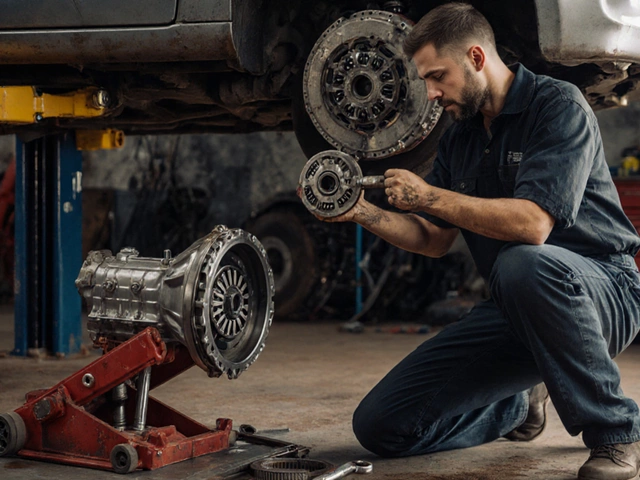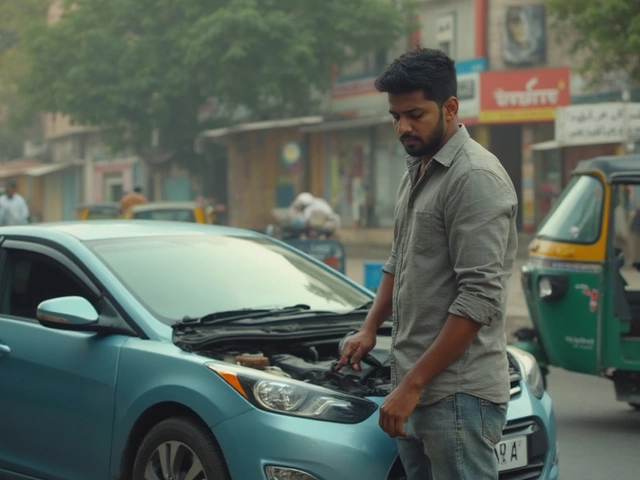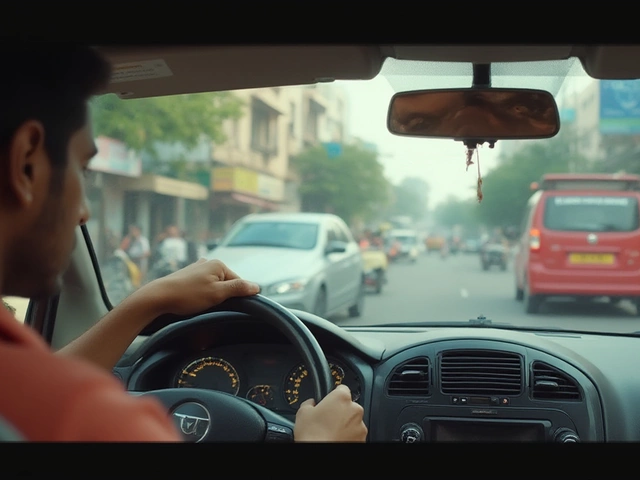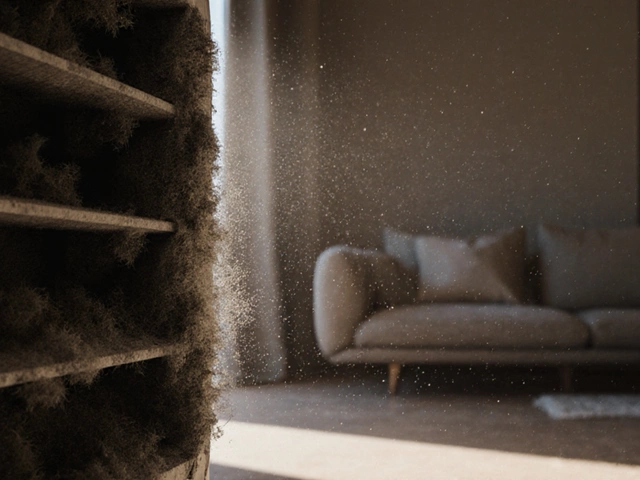
Your brakes aren’t supposed to sound like you’re dragging rocks down the street. When you hear that awful grinding noise, it’s usually your brake pads crying out for help. This sound almost always means metal is rubbing against metal somewhere in your braking system. That’s seriously bad news.
Lots of drivers try to ignore it, hoping the noise will magically disappear. Spoiler: it won’t. Those grinding sounds warn you that your brake pads are probably toast—either worn down to nothing or about to start chewing up expensive parts, like your rotors. Once you get to this stage, stopping your car takes longer and you might not stop at all in an emergency.
If you keep driving like this, you’re rolling the dice with your safety and your wallet. Worn brake pads aren't just loud and irritating—they turn every drive into a risk. The grinding is only going to get worse, and so will the damage. If you hear it, don’t wait around. It’s time to deal with your brakes before they deal you a bigger problem.
- What Does Grinding Brakes Really Mean?
- The Real Dangers Behind Driving on Bad Brakes
- What Happens If You Ignore the Sound?
- How Long Can You Actually Drive on Grinding Brakes?
- Checking and Replacing Worn Brake Pads
- Must-Know Tips to Stay Safe and Save Money
What Does Grinding Brakes Really Mean?
You hear your car making that ugly grinding noise when you hit the brakes. What’s actually happening? That sound is usually metal scraping on metal, and it almost always means your brake pads are so worn down that the metal backing plate is digging into your rotors. It’s not like a squeak or a light whine, which can sometimes be fixed with a bit of cleaning. Grinding means something is seriously wrong.
Brand-new brake pads compress against the rotors with a layer of durable friction material—this is what slows you down smoothly and quietly. But over miles and years, that material wears right off. Mechanics agree: once you hear grinding, there’s pretty much no pad left to cushion things. You’re hearing damage in real time.
Let’s break it down:
- Early signs, like squeaking, come from “wear indicators”—little metal tabs that touch the rotor when pads are nearly gone. They’re basically warning bells.
- Grinding means you’ve ignored those warnings or something failed early (like cheap pads or a broken caliper).
- Every pump of the pedal now risks warping or gouging the rotors, which cost way more than pads to replace.
- You might even hear the grinding when you’re not braking, which usually means broken hardware is rattling around in there.
"If your brakes are grinding, it usually means you have less than 3% of your brake pad material left. It’s a critical sign you’ve entered the danger zone and need service now." — National Highway Traffic Safety Administration (NHTSA)
| Noise Type | Likely Cause | Immediate Risk? |
|---|---|---|
| Squeaking | Wear indicator touching rotor | Not yet, but soon |
| Grinding | Metal on metal: worn pads or broken hardware | Yes, stop driving |
| Clicking | Loose caliper or pad | Medium, should fix |
People sometimes hope the noise might just be a bit of dust, but if the grinding is steady and gets worse when braking, it’s almost always damaged brake pads or rotors. Don’t count on luck—grinding brakes aren’t just a nuisance, they’re a red flag for unsafe car maintenance and real driving safety problems.
The Real Dangers Behind Driving on Bad Brakes
When your grinding brakes are screaming for attention, you’re actually risking a lot more than just an annoying noise. The dangers come fast and hit hard—sometimes literally. Worn-down brake pads can slash your stopping power, making those few extra feet the difference between a close call and a real accident. If you think that’s just scare talk, check out this stat: the National Highway Traffic Safety Administration (NHTSA) reports that poor brake conditions are a factor in over 20,000 reported crashes yearly in the U.S.
The worst part? When you press the pedal with bad brakes, metal grinds right into the rotors. The longer you drive like that, the thinner and weaker those rotors get. It doesn’t just mean noisy stops; it means unreliable brakes, longer stopping distances, and a total loss of control if things go really south. That’s a recipe for a fender bender, or something worse if you need to stop suddenly.
“Metal-on-metal contact is a sign of advanced pad wear and should be treated as an urgent repair need.” — AAA Car Guide, 2024
Ignoring grinding noises isn’t just risky; it gets real expensive, real quick. Here’s a breakdown of possible damage and what it can mean for your wallet:
| Part Affected | Repair Cost Range (USD) | Associated Risk |
|---|---|---|
| Brake Pads | $120-$250 | Reduced stopping power |
| Rotors | $300-$700 | Loss of braking efficiency, wobbling |
| Calipers | $400-$900 | Brake failure, locking up |
Plus, don't forget about safety. When brake pads are ground down, small pieces can break loose, or rotors can crack. Imagine what happens if your brakes stop working on a busy highway or at a traffic light. It’s a lot more than an inconvenience—it could be life-threatening for you and everyone around you.
The bottom line: driving with grinding brakes isn’t just unsafe, it’s stacking up bigger bills down the road. Take it seriously before your braking system decides when—and if—you stop.
What Happens If You Ignore the Sound?
Ignoring the grind of your brake pads isn’t just brushing off an annoying noise—it’s setting yourself up for bigger problems. When your brakes start grinding and you keep driving, you’re letting metal rub directly against metal because the pad material is either gone or practically gone. The longer you leave this alone, the more damage you rack up. And it isn’t just about money; your car’s safety drops fast.
Worn-out brake pads means your grinding brakes are likely chewing up your rotors every time you press the pedal. That turns a simple brake pad swap into a full-on brake job, which can cost three to five times more. Some mechanics see rotors so damaged they can’t even be resurfaced—they have to be replaced. Don’t forget: if your brakes overheat from metal-on-metal friction, there’s a chance you’ll lose stopping power right when you need it most.
Here’s exactly what can happen if you ignore grinding brakes:
- Longer stopping distances, especially in emergencies
- Brake fluid can overheat, weakening your braking action
- Parts like rotors and calipers get damaged, leading to expensive repairs
- ABS (anti-lock braking system) sensors can get destroyed by metal shavings
- You risk total brake failure—which basically means you could lose the ability to stop
For folks who think, "It can’t be that bad", check those costs:
| Issue | Average Cost (USD) |
|---|---|
| Just Brake Pads | $120–$300 |
| Brake Pads + Rotors | $300–$800 |
| Caliper Replacement | $600–$900 (per axle) |
Letting your car maintenance slide because you’re ignoring weird brake noises is risky. You’re not just looking at a bigger bill. You’re taking a real chance with your safety and everyone’s around you. So, grinding brakes? Don’t just turn up the radio. Get them checked ASAP.
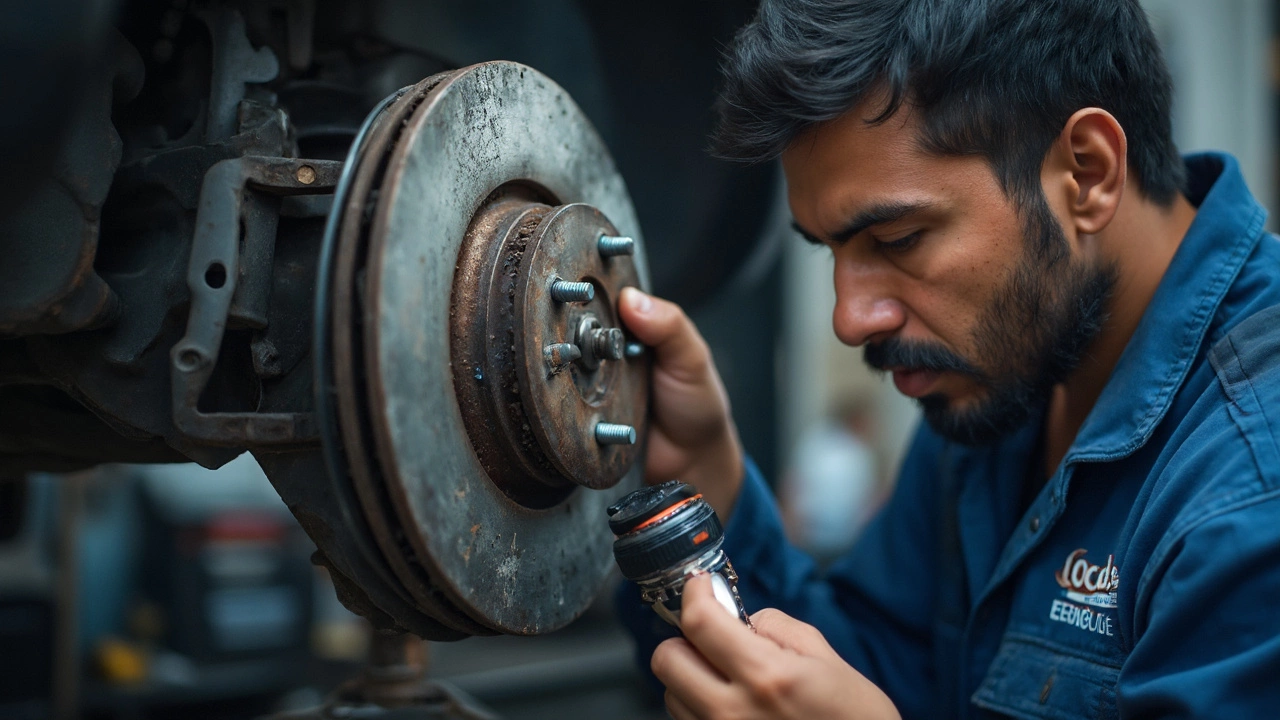
How Long Can You Actually Drive on Grinding Brakes?
So you’re cruising around and every time you hit the brakes, there’s that grinding sound. It feels risky but you’re wondering: how far can you push it before grinding brakes cause serious trouble? The answer is simple—you really shouldn’t push it at all.
The moment your brakes start to grind, the pad material is probably gone. You might have a few miles left—or even less—before bigger damage shows up. Some folks try to squeeze in “just one more week,” but this is straight-up playing with fire. According to the Car Care Council, “Driving on worn brake pads will destroy the rotors in as little as a few hundred miles, and the repair bill can easily double or triple.”
“If you hear grinding, your brake pads may already be completely worn, and continued driving will quickly damage other parts—sometimes within a single drive.” — Greg Brannon, Director of Automotive Engineering, AAA
In real life, you’ll see horror stories online—drivers who ignored the noise and ended up stuck on the side of the highway or facing $1,500 repair bills. The metal-on-metal contact chews up rotors and calipers, turning a $150 brake pad job into a massive project.
| Brake Problem | Typical Mileage Left | Repair Cost (USD) |
|---|---|---|
| Quiet Squeaking | 300-1000 | $150-$300 |
| Loud Grinding | 0-100 | $400-$1500+ |
| Brake Failure | 0 | $1500+ |
If you’re hearing grinding, safe driving is pretty much off the table. There’s no magic number of miles; it depends on the car, your driving style, and how severe the damage already is. Bottom line: Replace those brake pads ASAP. Waiting even a little longer just isn’t worth the risk or the cost.
Checking and Replacing Worn Brake Pads
Spotting worn-out brake pads isn’t just for gearheads or car pros; anyone can do a basic check. If you want a quick answer, just look through your wheel spokes. A new brake pad is usually about half an inch thick. If what you see looks thinner than a quarter, you’re overdue for a change. No need to measure with a ruler—if they’re barely there, it’s time.
There are a few classic signs your pads are shot and you’re heading toward those dreaded grinding brakes:
- Screeching or scraping sounds every time you stop
- A brake pedal that feels soft or squishy
- Brake warning light on your dashboard
If you’re hearing metal-on-metal, that means there’s almost no pad left and you’re damaging your rotors with every mile.
Replacing brake pads isn’t rocket science, but you need some tools and a little patience. If you want to save some cash, here’s the basic process:
- Park your car on a flat surface and secure it—chock the wheels for safety.
- Loosen the lug nuts, jack up the car, and remove the wheel.
- Find the brake caliper. Unscrew it and carefully slide it off. Don’t let it dangle by the hose—rest it somewhere safe.
- Slide out the old pads and compare them to your new ones—it’s always a wake-up call.
- Push the caliper piston back so there’s room for thicker new pads. This step is key.
- Install the new brake pads. Reattach the caliper and secure everything tightly.
- Put the wheel back on, tighten lug nuts, and lower your car.
Brake pad replacements at a shop usually run anywhere from $115 to $300 per axle in the US. If you do it yourself, new brake pads typically cost between $25 and $60 for a set. That’s a huge difference compared to what you’ll pay if grinding pads eat through your rotors or calipers.
| Brake Issue | Average Repair Cost (per axle) |
|---|---|
| Brake Pads Only | $25–$300 |
| Pads + Rotors | $250–$600 |
| Pads + Rotors + Calipers | $500–$1,000+ |
Checking your brake pads every few months is a smart move—especially if you do lots of city driving or haul heavy loads. Remember, tackling brake repair early keeps you safe and saves your wallet from a much nastier hit later on.
Must-Know Tips to Stay Safe and Save Money
If your grinding brakes are screaming for attention, don’t just crank up the radio and hope for the best. Here’s what actually helps protect your wallet—and your neck.
- Don’t Delay Repairs: Replacing brake pads as soon as you hear grinding is way cheaper than swapping busted rotors or calipers. Ignoring the noise usually means you’ll pay two or three times more for parts and labor later.
- Look for Deals: Lots of auto shops run specials on brake jobs. Ask about coupons, price matching, or bundle deals so you’re not overpaying.
- Check Both Axles: Brakes don’t wear at the same rate on the front and rear wheels. If one set is going bad, the other might not be far behind. Ask your mechanic to check all four wheels—not just the noisy ones.
- Change Both Pads and Rotors if Needed: Grinding usually means pads are gone, but sometimes rotors are too chewed up to save. Worn rotors make new pads wear out faster, so replacing both may save you a repeat trip.
- Buy Quality Parts: Cheap pads might sound good at checkout, but they often wear out quicker and can make grinding come back. Spend a bit more now and you’ll save having to replace them sooner.
- Schedule Regular Checks: Even if your car isn’t making noise, have your brake system checked at least once a year. Most shops will look at pad thickness and fluid levels during oil changes for free if you ask.
Here’s a quick look at what ignoring brake repair can cost you, based on average shop prices in the U.S. as of early 2025:
| Issue | Average Cost per Axle |
|---|---|
| Pad Replacement Only | $150-$300 |
| Pads + Rotors | $350-$600 |
| Full System (Pads, Rotors, Calipers) | $800+ |
If you act fast the first time you hear your brakes grinding, you’ll probably only need new pads. Wait too long, and those numbers get ugly fast.
And here’s something most drivers miss: using your brakes gently and leaving more space between you and the car in front actually stretches out the life of your brake pads. Not rocket science, but it works.
The key? Don’t gamble with driving safety. A little money spent on new brake pads and quick checks will save a pile of cash—and keep you out of the body shop.
